1
Introduction
WHAT ARE CUBESATS?
Space-based observations have transformed our understanding of Earth, its environment, the solar system, and the universe at large. During past decades, driven by increasingly advanced science questions, space observatories have become more sophisticated and more complex, with costs often growing to billions of dollars. Although these kinds of ever-more-sophisticated missions will continue into the future, small satellites ranging in mass between 500 kg to 0.1 kg—from microsatellites (10 kg-100 kg), nanosatellites (1-10 kg), and even picosatellites (0.1-1 kg)—are gaining momentum as an additional means to address targeted science questions in a rapid, and possibly more affordable, manner. Within the category of small satellites, CubeSats have emerged as a space-platform defined in terms of (10 cm)3-sized units of approximately 1.3 kg each called “U’s.” Historically, CubeSats were developed as training projects to expose students to the challenges of real-world engineering practices and system design. Yet, their use has rapidly spread within academia, industry, and government agencies both nationally and internationally (see Figure 1.1 for examples of CubeSats).
In particular, CubeSats have caught the attention of parts of the U.S. space science community, which sees this platform, despite its inherent constraints, as a way to affordably access space and perform unique measurements of scientific value. The first science results from such CubeSats have only recently become available; however, questions remain regarding the scientific potential and technological promise of CubeSats in the future.
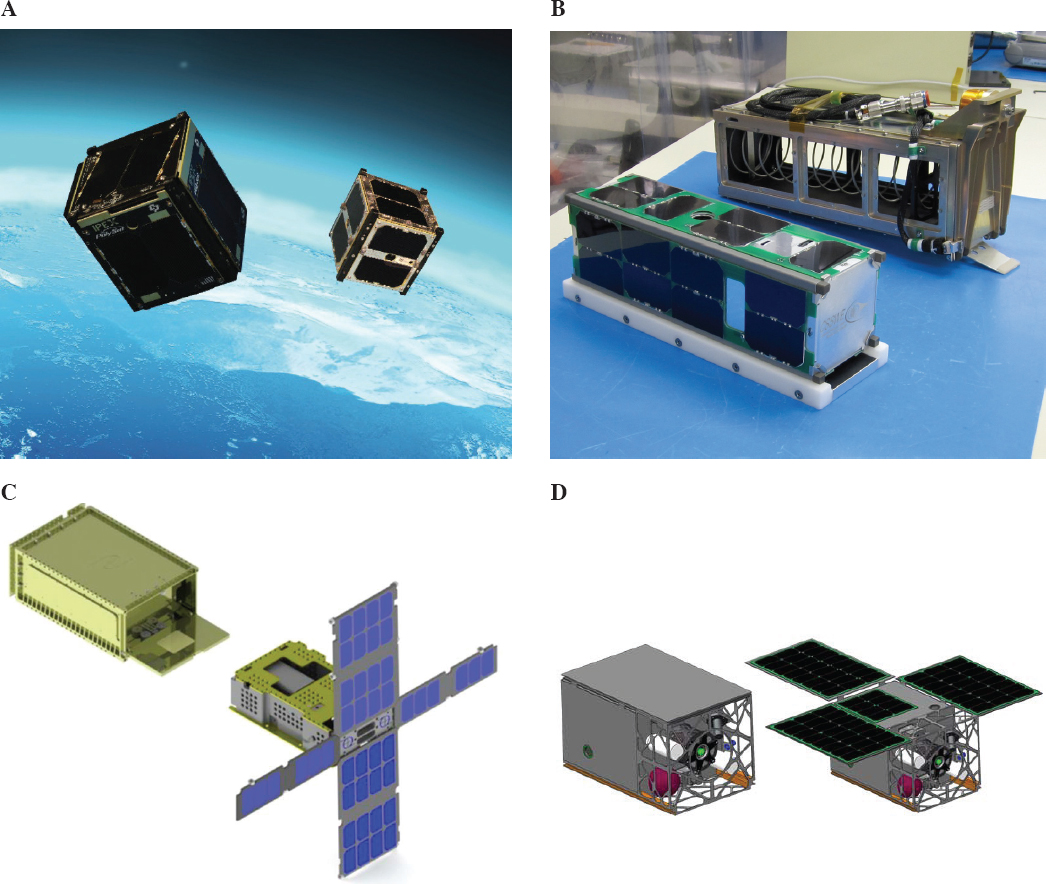
RATIONALE FOR THE CREATION OF THE COMMITTEE ON ACHIEVING SCIENCE GOALS WITH CUBESATS
This committee, under the auspices of the National Academies of Sciences, Engineering, and Medicine and called for by the National Aeronautics and Space Administration (NASA) and National Science Foundation (NSF), was charged to review the current state of the scientific potential and technological promise of CubeSats. This
assessment focuses on the platform’s promise to obtain high-priority science data, as defined in recent decadal surveys1 in astronomy and astrophysics,2 Earth science and applications from space,3 planetary science,4 and solar and space physics (heliophysics)5; the science priorities identified in the 2014 NASA Science Plan; and the potential for CubeSats to advance biology and microgravity research. Using the study objectives from the committee’s statement of task (provided in Appendix A), the specific actions to the committee are listed below. Table 1.1 provides a “map” of the report.
- Develop a brief summary overview of the status, capability, availability, and accomplishments of a selection of existing CubeSat programs in the government, academic, and industrial sectors.
- Recommend any potential near-term investments that could be made (a) to improve the capabilities that have a high impact on the increased science and technology return—thereby increasing the value of CubeSats to the science community—and (b) to enable the science communities’ use of CubeSats.
- Identify a set of sample priority science goals that describe near-term science opportunities—such as providing continuity of key measurements to mitigate potential gaps in measurements of key parameters—and that can be accomplished given the current state of CubeSat capabilities.
HISTORY AND GROWTH OF CUBESATS
An Educational Beginning
The promise of CubeSats for education and training (formal, informal, and early career development) is that they are relatively affordable and that they provide easy access to space. This is achieved through standardized interfaces and, especially, picosatellite deployment mechanisms that can be added to launch vehicles as secondary payloads. The initial development of such a mechanism in the 1990s by Aerospace Corporation (i.e., the Orbiting Picosatellite Automated Launcher (OPAL)) led Robert Twiggs (then at Stanford University) to develop the initial CubeSat concept in early 1999. Jordi Puig-Suari from California Polytechnic State University (Cal Poly) at San Luis Obispo helped refine this concept and created the specifications for the Poly Picosatellite Orbital Deployer (P-POD, canister) (Figure 1.2). Eight OPAL-based picosatellites were launched in 2000-2001 on U.S. Minotaur-1 rockets.6 Six CubeSats were first launched using the P-POD in 2003 aboard a Russian Rokot launch vehicle, with three more CubeSats aboard a Kosmos-3M rocket in 2005. The larger P-POD displaced the smaller OPAL deployer, and most of the CubeSats launched in 2006 to the present time have utilized the 3U P-POD or similar form-factor 3U and 6U deployers.
During the same time, CubeSat-specific technology developments began within universities, government agencies, and industry with funding primarily from various agencies within the United States. In 2008, university groups led nearly three-quarters of all CubeSats launched. Educational institutions that were focused both on engineering of space systems and on space sciences were engaging preferentially in this novel activity. A partnership between NASA and Santa Clara University led to the first science-based NASA CubeSat, a bacterial life support experiment called GeneSat that was launched in December 2006. As technology has matured, the focus for CubeSats has increasingly turned toward high-value commercial and science-focused missions.
___________________
1 The National Research Council (NRC) has conducted 11 decadal surveys in the Earth and space sciences since 1964 and released the latest four surveys in the past 8 years. Through a rigorous process, a primary survey committee and thematic panels of community members construct a prioritized program of science goals and objectives and define an executable strategy for achieving them. These reports play a critical role in defining the nation’s agenda in that science area for the following 10 years, and often beyond (National Academies of Sciences, Engineering and Medicine, 2015, The Space Science Decadal Surveys: Lessons Learned and Best Practices, The National Academies Press, Washington, D.C.).
2 NRC, 2010, New Worlds, New Horizons in Astronomy and Astrophysics, The National Academies Press, Washington, D.C.
3 NRC, 2007, Earth Science and Applications from Space: National Imperatives for the Next Decade and Beyond, The National Academies Press, Washington, D.C.
4 NRC, 2011, Vision and Voyages for Planetary Science in the Decade 2013-2022, The National Academies Press, Washington, D.C.
5 NRC, 2013, Solar and Space Physics: A Science for a Technological Society, The National Academies Press, Washington, D.C.
6 The OPAL picosatellites—characteristic of the CubeSat standard that was developed later—are included in all statistics given they represent the early development of the field.
TABLE 1.1 Report Map of Objectives as They Are Addressed in Chapters 1-7
| Objective 1: Summary of Status | Objective 2: Recommend Investments | Objective 3: Identify Sample Priority Science Goals | |
|---|---|---|---|
| Chapter 1 | Accomplishments and status, NASA and NSF programs, mission success | ||
| Chapter 2 | Interpretation of development as disruptive innovation | ||
| Chapter 3 | Educational role | ||
| Chapter 4 | Publication overview, ongoing science programs and planned missions | Identify technology gaps for high-priority science missions | Sample priority science goals in each discipline |
| Chapter 5 | Technological progress & growth of industrial sector | ||
| Chapter 6 | Policy relevant data such as orbital debris, communications, and launch rates | Identify policy challenges to future growth of CubeSats | |
| Chapter 7 | Recommend near-term investments for NSF, NASA | Sample science priorities and constellation focus |
Growth of an Industry
The pace of CubeSat development accelerated rapidly in the mid-2000s with an expansion of both the number and the type of organizations beyond those focused on education or technology development, as illustrated in Figure 1.3. During this time, NASA was increasing its investments in CubeSats primarily for technology development (such as technology maturations toward higher technology readiness levels (TRLs)) and training objectives. In 2007, the Geospace Science Section at NSF pioneered the role CubeSats could fulfill for space weather research by establishing a funded program in 2008 that was focused on science and education. After 2010, new commercial players were emerging as technology providers and also as companies developing and launching entire CubeSat systems (for discussion of the commercial sector, see Chapter 6). In 2013 through 2015, the commercial CubeSat launches provided approximately 55 percent of all CubeSats, university-led launches consisted of approximately 21 percent, and government (military, NASA, and NSF) provided the remaining 24 percent. By the end of 2015, 425 CubeSats had been launched, bolstered significantly by the growth of commercial applications for CubeSats in Earth observation and communications. For example, 71 percent of the CubeSat launches in 2014 were commercial Earth-imaging CubeSats for the U.S. firm Planet Labs, carried in NanoRacks or ISIPOD deployers. Another factor contributing to the increasing number of CubeSat launches is the opportunity for CubeSats to fly as secondary payloads on the frequent re-supply missions to the International Space Station (ISS). For example, 72 percent of the CubeSat launches in 2014 were to the ISS using the NanoRacks canister.7,8 Of the 425 CubeSats launched, NASA and NSF have launched 19 CubeSats focused explicitly on science objectives, as discussed in the section “The Current NSF and NASA CubeSat Programs.”
___________________
7 This report counts CubeSats integrated into a launch vehicle with a successful liftoff, even if they failed to deploy on orbit due to a subsequent launch vehicle failure.
8 The statistics throughout this report include all CubeSat missions and associated spacecraft through December 31, 2015, except where specifically noted. The most widely used sources are based on the following references: M. Swartwout, CubeSat Database, https://sites.google.com/a/slu.edu/swartwout/home/cubesat-database#refs, adjusted and updated by the committee; Gunter’s Space Page, http://space.skyrocket.de/doc_sat/cubesat.htm; and Earth Observation Portal Satellite Mission Database, https://directory.eoportal.org/web/eoportal/satellite-missions. Data from these public sources were adjusted and updated by the committee with assistance from NASA and NSF within this report to correct errors and to account for missing information.
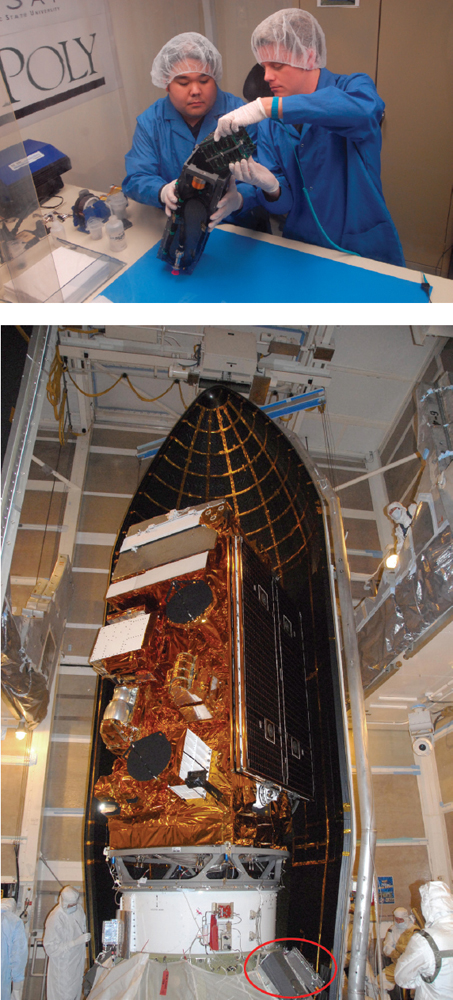
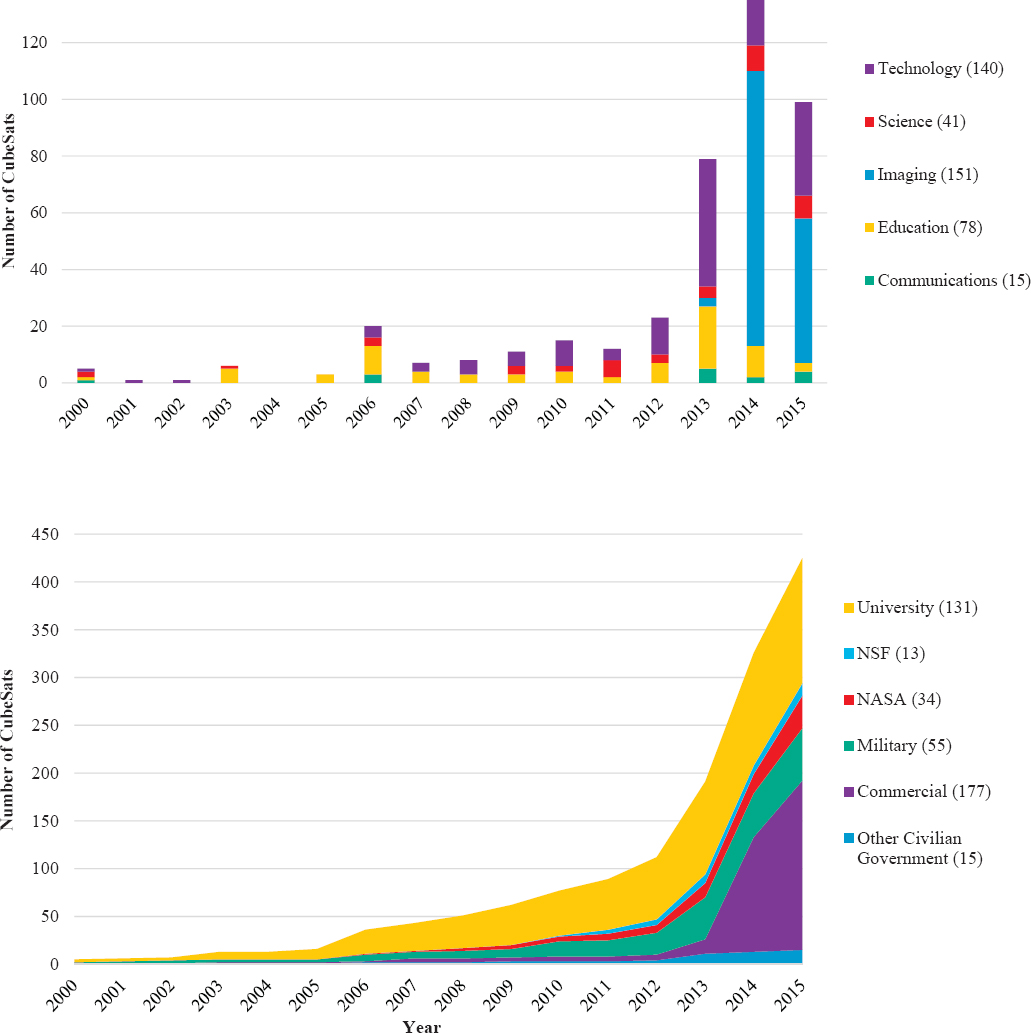
GROWTH OF THE COMMUNITY
The primary conferences regarding CubeSats have generally been the CubeSat Developer’s Workshop, held annually in April at Cal Poly; the AIAA/USU Conference on Small Satellites; the 4S Symposium: Small Satellite Systems and Services; and the European CubeSat Symposium. Although the CubeSat Developer’s Workshop and the Conference on Small Satellites will enter their 13th and 30th years, respectively, the number of new CubeSat meetings throughout the world has grown both in number and in attendance. Furthermore, specific meetings addressing ongoing and proposed CubeSat science have been introduced, such as the NSF 2011 Workshop on CubeSats for GEM and CEDAR Science, along with other GEM/CEDAR workshops, that represent important venues for the geosciences community to share their CubeSat flight results. Other meetings include the iCubeSat Workshops, Lunar Cubes Workshops, and Interplanetary Small Satellite Conferences that have been created to focus exclusively on beyond-low Earth orbit (LEO) science exploration and technology maturation with CubeSats. Furthermore, major scientific meetings have now incorporated CubeSats as part of the scientific agenda. The American Geophysical Union (AGU) had a total of 189 CubeSat-related oral and poster presentations from 2001-2015. Only 3 submissions to AGU were found from 2001-2008, and the first dedicated science session on “The Scientific Promise of Nanosatellites and CubeSats to Advance Geospace and Upper Atmospheric Science” was held in 2009 where a total of 31 topics were presented. This trend has increased with a total of 52 presentations at the 2015 AGU Fall meeting, representing the largest number to date, including a NASA-organized session under the theme of Disruptive Technologies in Space called “Taking SmallSats to the Next Level, Enabling New Science.” Other science meetings, such as the Lunar and Planetary Science Conference and the American Astronomical Society have also held a growing number of CubeSat sessions with broad participation.
An illustration of the growth of the community is the attendance statistic at the Utah Conference on Small Satellites, the leading conference for CubeSats and other small satellite platforms, which has tripled from 600 prior to the launch of the first P-POD CubeSat in 2003 to more than 1,800 in 2015, as shown in Figure 1.4. While the numbers do not necessarily reflect only growth of the CubeSat community, according to the conference organizers, the rapid upticks of interest in 2003 and in 2013 were related to a broader engagement of science and engineering groups and then commercial entities, respectively.
Student interest in CubeSats has moved from a community almost entirely of undergraduate students—mostly from engineering-focused departments at U.S. universities—to nearly 50 percent graduate students who use these platforms for engineering and scientific research. In fact, the Conference on Small Satellites provides a research award for such graduate students, judged by sets of referees from private industry and federal agencies. Furthermore, the fraction of industry attendees has increased over time as well; several of the start-up entrepreneurs and investors registering as “self” are using the conference to assess technology and market trends.
Given their affordability and short development life cycles, CubeSats have attracted global interest. For many countries, such as Uruguay, CubeSats are the country’s first forays into space. However, as Figure 1.5 illustrates, the United States currently is the dominant player in the community. Thirty-six different countries (led by Japan, Germany, and Denmark) have launched at least one CubeSat. For most of these countries, the numbers are in the single digits but are expected to grow. Figure 1.5 also shows the addition of countries by year (excluding the United States for clarity). The first countries outside the United States to launch a CubeSat were Canada, Denmark, and Japan (in 2003).
An interesting observation with respect to global launches of CubeSats is that although commercial actors now dominate the United States, for other countries, the launches are almost entirely led by universities.
THE CURRENT NSF AND NASA CUBESAT PROGRAMS
Pioneering CubeSats funded by NASA from 2006-2010, such as GeneSat, focused on space biology and were developed by NASA’s Ames Research Center and partner organizations. Following these initial NASA-funded developments, NSF has since led the nation in the development of science-driven CubeSat programs and, to date, provides a large fraction of the flight heritage of science-driven missions. The NSF program of CubeSat-based science missions for geospace and atmospheric research issued a first call for proposals in 2008. Thus far, five
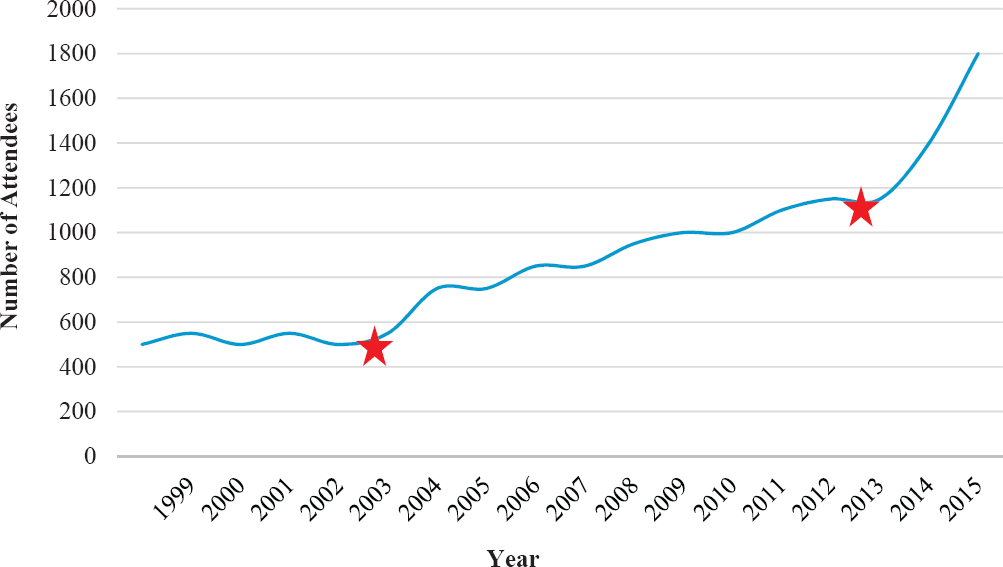
such calls have been issued, and the next solicitation is expected in the summer or fall of 2016. The number of selected CubeSats is limited by the available budget, which is approximately $1.4 million/year, although supplemental funding from industry and other sources have contributed support. As of the end of 2015, NSF has launched 8 missions for a total of 13 CubeSats. According to the NSF program manager, all but one selected mission has been successful at providing science measurements so far, although three of them required a reflight to address a spacecraft anomaly. This includes Radio Aurora Explorer (RAX)-1, which was reflown as the RAX-2 mission (see Figure 1.7). NSF has 7 missions with a total of 11 CubeSats in development. It is noteworthy how well NSF’s CubeSat program aligns with the first recommendation of the 2013 decadal survey Solar and Space Physics: A Science for a Technological Society.9 The survey recommended the implementation of the DRIVE10 initiative, which called out very small satellite flight opportunities, including CubeSats, as a growth area for both NSF and NASA. (See Chapter 4, “Solar and Space Physics” for details.)
The next significant increase for science-based CubeSat missions occurred in 2013, when NASA provided multiple opportunities for the space science community to propose science-based CubeSat missions. During this period, a significant increase in launches also occurred for NASA technology and NSF science CubeSats. As of the end of 2015, NASA has launched 18 missions for a total of 34 CubeSats with science and technology objectives. NASA has 39 missions for a total of 46 CubeSats in development (Table 1.2). Of the total NASA CubeSat missions, 33 percent have goals that are science-based and 67 percent have goals that are technology-based. These
___________________
9 NRC, 2013, Solar and Space Physics: A Science for a Technological Society, The National Academies Press, Washington, D.C.
10 DRIVE stands for diversify, realize, integrate, venture, and educate.
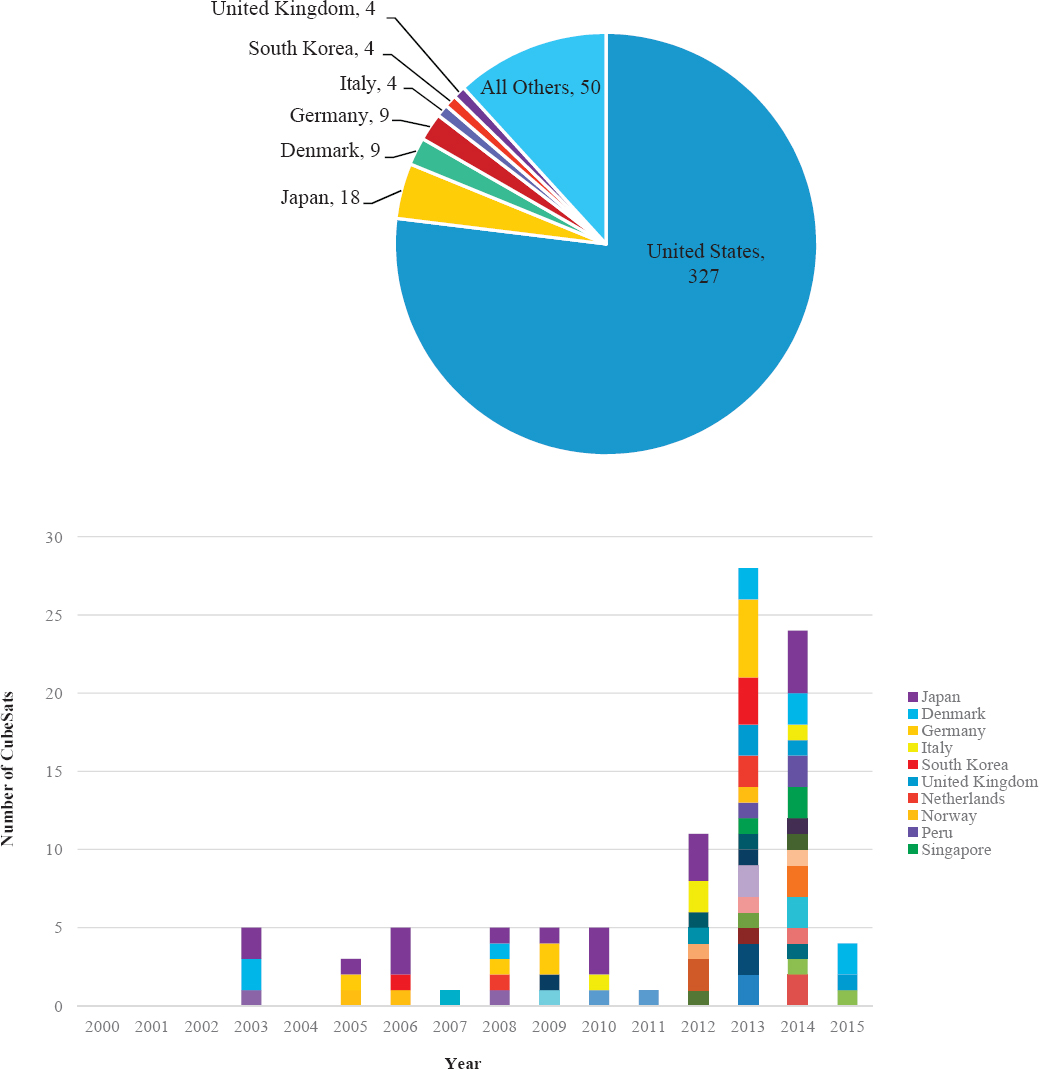
TABLE 1.2 Summary of CubeSat Statistics for NASA and NSF that Launched in 2006-2015 or are in Development for Launch 2016-2018+
| Launch Dates | NASA Science | NASA Technology | NSF Science | Total |
|---|---|---|---|---|
| 2006-2015 | 6 CubeSats (6 missions) | 28 (12) | 13 (8) | 47 (26) |
| Planned 2016-2018+ | 14 (13) | 32 (26) | 11 (7) | 57 (46) |
| Total | 20 (19) | 60 (38) | 24 (15) | 104 (72) |
| CubeSats (number of missions) by Science Category | |||||||
| Launch Dates | Technology | Astronomy and Astrophysics | Biological and Physical Science | Earth Science | Solar and Space Physics | Planetary Science | Total |
|---|---|---|---|---|---|---|---|
| 2006-2015 | 28 (12) | 0 (0) | 4 (4) | 1 (1) | 14 (9) | 0 (0) | 47 (26) |
| Planned 2016-2018+ | 32 (26) | 1 (1) | 4 (3) | 7 (3) | 10 (10) | 3 (3) | 57 (46) |
| Total | 60 (38) | 1 (1) | 8 (7) | 8 (4) | 24 (19) | 3 (3) | 104 (72) |
NOTE: Some missions consist of more than one CubeSat, or the original single CubeSat was reflown. These CubeSat statistics include all launched missions, including those that were lost due to launch failures. Launch dates from 2016-2018 are presented as a forecast of future activities.
projects span all four NASA Science Mission Directorate (SMD) science divisions, the Space Technology Mission Directorate (STMD), the Human Exploration and Operations Mission Directorate (HEOMD), and NASA centers. A total of 104 CubeSat spacecraft have launched or are in development under NASA and NSF support through the year 2018 (see also Table 1.3 in the section “Future NASA CubeSat Programs”).11
Figure 1.6 shows the 47 total NASA and NSF CubeSats through 2015 where, cumulatively, 19 focused explicitly on science objectives and 28 were technology-driven across both agencies. Examining these 19 science CubeSats from NASA and NSF, there were 14 that focused on solar and space physics, 4 on biological and physical science, 1 on Earth science, and none in astronomy and astrophysics or planetary science through 2015. NASA’s current emphasis on technology is shown through the 28 CubeSats launched through 2015, but they were driven by SMD science themes. All of the NSF missions were science-focused. In preparation for launches from 2016 to 2018, NASA has 32 technology-focused and 14 science-focused CubeSats in development, and NSF is sponsoring 11 science-focused CubeSats. Of the 25 science CubeSats planned from 2016 to 2018 by NASA and NSF, 1 is in astronomy and astrophysics, 4 are in space/microgravity science, 7 are in Earth science, 10 are in solar and space physics, and 3 are in planetary science, where a number of these CubeSats will travel beyond LEO. Selected NASA- and NSF-funded CubeSats, shown in Figure 1.7, also illustrate some of the diversity in CubeSat science objectives.
NASA CubeSat programs are spread among STMD, SMD, and HEOMD and thus have a range of program objectives. STMD describes the objectives for its CubeSat program as “focused technology development and demonstration in relevant space environments,” furthering its existing objectives to develop flight hardware for use by the other mission directorates. STMD missions are competitively selected through solicitations from the Small Spacecraft Technology Program, and the directorate has funded 8 technology CubeSat missions (23 spacecraft) to date.
SMD describes its CubeSat vision as “cutting edge science, instrument technologies, and student flight investigations.” CubeSat programs are operated individually by each of SMD’s science divisions and solicited by NASA Research Announcements through the Research Opportunities in Space and Earth Sciences (ROSES) system. In 2013, SMD received a new budget line item of $5 million per year as an additional means to support CubeSat sci-
___________________
11 Science categories were decided based upon funding programs and information available in the public domain without contacting each CubeSat team.
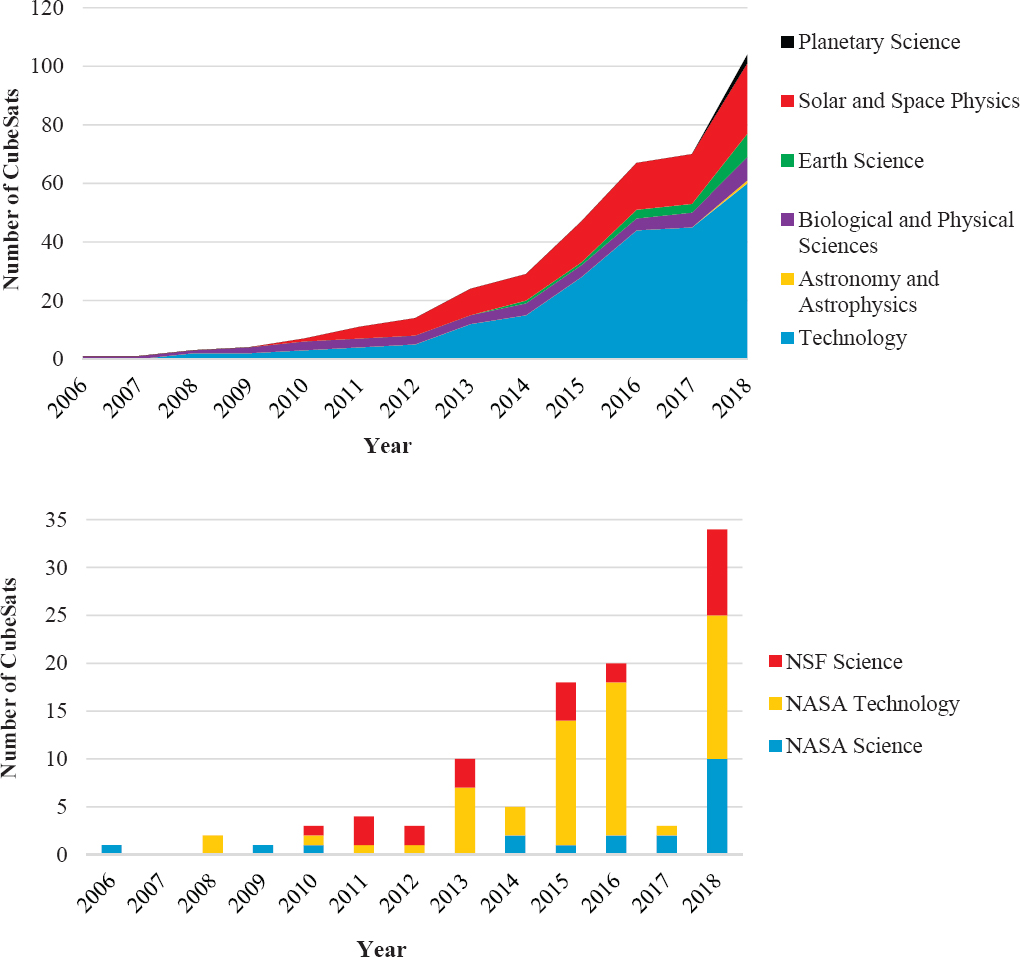

ence and technology validation missions.12 To date, the Earth Science Division has funded 13 CubeSat missions (14 spacecraft), all for technology development with the goal to enhance capabilities for future small science missions. The Heliophysics Science Division has funded 7 CubeSat missions (7 spacecraft), all for science, including ELFIN jointly with NSF.13 The Planetary Science Division (PSD), which currently includes astrobiology within its purview, has funded 5 CubeSat missions (7 spacecraft), including two spacecraft under the SIMPLEx program and the remaining five under direct PSD support. SIMPLEx separately awarded three additional CubeSat projects for ground-based technology development. The Astrophysics Science Division only awarded one science CubeSat thus far, through the Astrophysics Research and Analysis (APRA) program.
HEOMD competitively makes launch opportunities available to institutions that are NASA centers, U.S. not-for-profit organizations, or U.S.-accredited educational institutions via the CubeSat Launch Initiative (CSLI). CSLI, which has successfully launched 43 CubeSats as of the end of 2015,14 identifies opportunities for CubeSat launches as secondary payloads and assists with the integration of CubeSats aboard launch vehicles. HEOMD also directly sponsors CubeSats under the Advanced Exploration Systems (AES) program, which has funded 9 CubeSat missions (10 spacecraft) to date that support science in response to human exploration objectives such as BioSentinel, Lunar Flashlight, and others. HEOMD is also working with the AES program to offer the opportunity to deploy CubeSats into deep space aboard the inaugural launch of the Space Launch System planned in 2018.
NASA’s STMD Centennial Challenge Program has also sponsored the Cube Quest Challenge, which offers $5.5 million to teams that can successfully design and build one or multiple CubeSats (with a total volume of 6U) that can demonstrate advanced operations near and beyond the Moon. Organized across a series of three stages (Ground Tournaments, Deep Space Derby, and Lunar Derby), the objective of the challenge is to incentivize innovation in the development of CubeSat capabilities in communication, propulsion, navigation, and durability to enable future deep space missions. Deep Space Derby and Lunar Derby prizes will be awarded based on metrics for burst data rate, largest aggregate data volume, and spacecraft longevity at a minimum range of 4 million km (Deep Space) or lunar orbit (Lunar), respectively. Deep Space Derby will also award prizes for the farthest com-
___________________
12 This does not include the TROPICS 12 CubeSat constellation science mission awarded through the Earth Venture Instruments-3 solicitation announced in March 2016.
13 The ELFIN (Electron Losses and Fields Investigation) mission, originally a part of the University Nanosatellite Program, is now funded jointly by NASA and NSF.
14 CSLI has successfully integrated 49 CubeSats as of December 2015, but 6 of those were lost due to the launch vehicle failures of the 2011 Taurus XL (3), 2014 Antares/Cygnus (1), and 2015 Super Strypi (2).
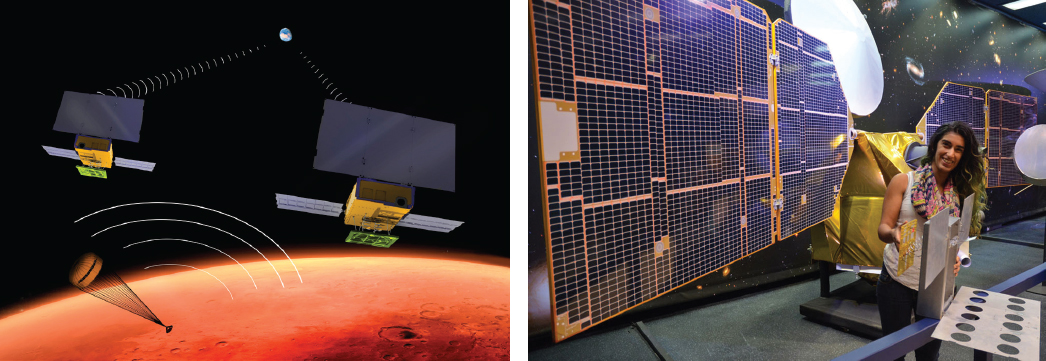
munication from Earth, while the Lunar Derby will award prizes for achieving at least one verifiable propulsive lunar orbit. Cube Quest teams may be offered launch opportunities as secondary payloads aboard the NASA Orion (EM-1) spacecraft atop the Space Launch System (planned for launch no earlier than 2018), provided a variety of conditions are satisfied as described within the Cube Quest Challenge Operations and Rules document.
FUTURE NASA CUBESAT PROGRAMS
The growth in CubeSat usage as a tool for education, technology development, and science is unlikely to abate in the near future. For example, two 6U interplanetary CubeSats, MarCO-1 and MarCO-2, are expected to launch on the same Atlas-V launch vehicle with NASA’s InSight lander at the 2018 launch opportunity (Figure 1.8). These spacecraft are designed to support a real-time 8 kbps UHF to X-band bent-pipe relay of transmissions from InSight on entry-descent-landing through the Mars atmosphere, demonstrating new technologies (e.g., deep space telecom, navigation and tracking via NASA’s Deep Space Network, and propulsion) and providing auxiliary communications—potentially enabling CubeSat applications beyond Earth orbit. EM-1, the maiden flight of the Space Launch System, is also expected to include a number of CubeSats as secondary payloads, lofting them to lunar and heliocentric orbits for a variety of scientific purposes and technology demonstrations. Furthermore, 10 universities are currently exploring CubeSat science mission concepts that could potentially enhance the NASA Europa Clipper mission concept under study. These, and other future opportunities, are partially enabled by accelerated industry growth, which will likely lead to enhanced technological capabilities, standards, and, ultimately, science.
Table 1.3 summarizes all known NASA and NSF CubeSat missions and associated spacecraft per mission. Although universities, industry, and NASA centers, including JPL, lead the NASA missions listed in Table 1.3, the missions are classified by the program sponsor, with a separate category for missions funded internally by NASA centers or JPL. Undoubtedly, there are many science and technology mission proposals beyond those that are represented in Table 1.3 that have not been selected for funding.
There has been a rapid growth of CubeSat programs across NASA and in several NASA centers. Each of the four Science Mission Directorate science divisions, at least two other directorates, and at least five NASA centers are developing CubeSat missions. Additionally, some of the science divisions and centers may have more than one funding opportunity for CubeSats. With the exception of the CubeSat Launch Initiative, CubeSat activities within NASA’s programs have remained largely independent.
TABLE 1.3 Known CubeSat Projects Funded by NASA or the National Science Foundation During Launch Years 2006-2018
| Funding Program | CubeSat Missions Launched | CubeSat Missions Planned | Launch Years |
|---|---|---|---|
| NASA | |||
|
Heliophysics |
MinXSS | CeREs, CuSP, ELFIN,a HeDI, SORTIE, TBEx | 2015-2018 |
|
Earth Science |
GRIFEX, IPEX, MCubed/COVE (2) | CIRAS, CIRiS, CubeRRT, HARP, IceCube, LMPC, MiRaTA, RainCube, RAVAN, TEMPEST-D | 2011-2018 |
|
Planetary Science |
O/OREOS | INSPIRE (2), LunaH-Map, MarCO (2), Q-PACE | 2010-2018 |
| Technology Development Only: DAVID, HALO, MMO | |||
|
Astrophysics |
HaloSat | 2018 | |
| Advanced Exploration Systems and Human Exploration and Operations | GeneSat, PharmaSat, SporeSat (2) | BioSentinel, EcAMSat, Lunar Flashlight, Lunar IceCube, NEA Scout, Skyfire | 2006-2018 |
| Space Technology | EDSN (8),b NODeS (2), OCSD-1, PhoneSat (5) | CPOD (2), CSUNSat-1, ISARA, iSAT, OCSD (2) | 2013-2017 |
| Centers (Internal) | 2008-2018 | ||
|
Ames Research Center |
PreSat,c TechEdSat (3) | KickSat, TechEdSat-5 | |
|
Ames Research Center and Marshall Space Flight Center |
NanoSail-D (2) | ||
|
Goddard Space Flight Center |
CANYVAL-X, Dellingr, ESCAPE, RBLE | ||
|
Jet Propulsion Laboratory |
LMRST, RACEd | ASTERIA, MITEE | |
|
Kennedy Space Center |
Cryocube, StangSat | ||
|
NASA IV&V Facility |
STF-1 | ||
| National Science Foundation | |||
| CADRE, CSSWE, CINEMA-1, DICE (2), ExoCube, FIREBIRD (4), Firefly, RAX (2) | ELFIN,a ISX, IT-SPINS, LAICE, OPAL, QBUS/QB50 (4), TRYAD (2) | 2010-2018 | |
NOTE: NASA has sponsored 57 missions (80 CubeSats total) and NSF has sponsored 15 missions (24 CubeSats total) for a total of 72 missions with 104 CubeSats across NASA and NSF.
CubeSats are counted by individual spacecraft, but missions are counted once even if they involve a reflight or multiple spacecraft. Numbers in parentheses after a mission name indicate the total number of CubeSat spacecraft counted in the mission. Acronyms are defined in Appendix E.
a The ELFIN (Electron Losses and Fields Investigation) mission, originally a part of the University Nanosatellite Program, is now funded jointly by NASA and NSF.
b Super Strypi launch failure.
c Falcon-1 launch failure.
d Antares launch failure.
OTHER U.S. GOVERNMENT PROGRAMS
In addition to CubeSat work within NSF, NASA, universities, and industry, other government organizations have been active in developing, sponsoring, and launching these systems. The University Nanosatellite Program (UNP) (see Chapter 4), administrated by the Air Force Office of Scientific Research (AFOSR), the Air Force Research Laboratory (AFRL), Space Missile Command (SMC), and the Department of Defense (DoD) Space Test
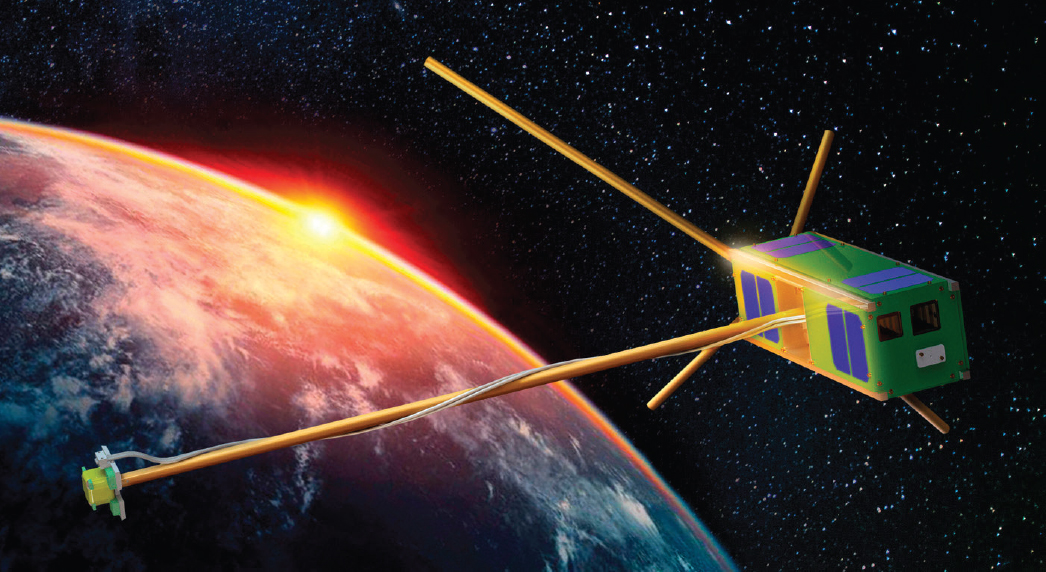
Program (STP), provides a multiyear program for students to design, build, and fly a small satellite. Many of these STP-funded missions have focused on flying new technologies, but there have been science selections as well. The University of Colorado’s PolarCube, for example, will fly a radiometer to perform tropospheric temperature soundings at 118 GHz O2 emission resonance. Furthermore. ELFIN from the University of California, Los Angeles, will investigate the mechanisms responsible for the loss of relativistic electrons from the radiation belts (Figure 1.9).
The National Reconnaissance Office (NRO) has also been an active participant developing CubeSat buses, providing rideshare opportunities to space with NRO primary payloads, and developing CubeSat missions for NRO programs. Indeed, NASA CSLI selected CubeSats have regularly been deployed in space on NRO launches. In 2007, NRO, the Air Force, and NASA collaboratively determined that CubeSats could have a role in supporting government applications. Shortly afterward, in 2008, NRO’s Advanced Systems and Technology Directorate provided funding to advance CubeSat subsystem and technology payloads. While the specifics of NRO’s developments are not in the public domain, NRO has partnered with numerous organizations, indirectly enabling capabilities that have supported the work of others for technology validation and science measurements. This includes 16 government agencies, 5 major academic partners, and 6 commercial partners to date.
Additional government agencies, as discussed in Chapter 6, support CubeSat missions by providing a legal and regulatory framework. For example, CubeSat operators are required to obtain radio licenses, either from the National Telecommunications and Information Administration (NTIA) for federal government CubeSats or from the Federal Communications Commission (FCC) for nonfederal CubeSats. Under Title 51 of the United States Code, “National and Commercial Space Programs” (P.L. 111-314), private CubeSats involved in remote sensing need to apply for a license from the National Oceanic and Atmospheric Administration (NOAA). In addition, the Air Force Joint Space Operations Center (JSpOC) has provided the website spacetrack.org for the community to acquire orbital position data for identification and tracking purposes of CubeSats in low Earth orbit. This has been a valuable, free resource to ground operation teams and to the worldwide community of HAM (handheld amateur radio) radio operators that often participate in tracking and decoding telemetry beacon transmissions from
CubeSats worldwide. Although the JSpOC capabilities were not originally designed for this purpose, their service has directly helped enable the growth of CubeSats for Earth exploration missions.
CUBESAT SUCCESS AND RELIABILITY
During the course of this study, the committee heard a wide range of impressions about the success rate for CubeSats and whether their reliability has improved since their early use as educational tools. Whether or not a CubeSat achieves success is based on meeting mission objectives that can encompass science, technology, and education. For the purposes of this analysis, a mission is defined as a full success when the CubeSat has operated in-orbit nominally and has completed its mission objectives. A mission is defined as a partial success when the CubeSat has completed commissioning, is in primary operations, and is taking actions to achieve primary mission objectives.
An analysis of all CubeSats launched through 2015 indicates that 67 percent of them have been considered successful in orbit if they achieved full success (33 percent) or partial success (34 percent) criteria (Figure 1.10). This average 67 percent success rate for all CubeSats should be considered in the context of the expected reliability design goals for NASA Class C/D missions at ~80 percent and NASA Class A/B and NOAA operational missions at ~90 percent. With concerns about the lower reliability for CubeSats, an effective design practice often adopted is a “fly-learn-refly” approach (used with Aerospace Corporation and also the NSF CubeSat program), in which two flight models are developed and the second flight model is modified and launched if any issues arise during the first flight. This CubeSat development approach may, in part, explain why CubeSat missions in the past 8 years (2008-2015) have been significantly more successful (full and partial success), at 71 percent, than in the first 8 years (2000-2007), at 35 percent.
As perhaps expected, education-only CubeSats have had a lower success rate of 45 percent for in-orbit performance compared to all CubeSats. When used as an educational tool, the science or technology objectives of CubeSat missions are not usually considered the highest priority because most of the learning objectives are achieved during the designing, building, and testing of the CubeSat. While the educational CubeSats may not be listed as successful by the above definition of success, largely based on in-orbit performance, these CubeSats are successful in meeting their educational objectives and play an important role in training the next generation of space engineers and scientists.
The fly-learn-refly approach also seems justifiable from the analysis of small satellite success rates reported by Richardson et al.15 The overall success rate for their sample of small satellites was approximately 84 percent, as defined as the number of CubeSats to be fully successful and half the number of CubeSats that have partial success. The study showed that there was no significant difference between CubeSats and small satellites that are not consistent with the CubeSat form factor. The most important predictor for success in this study was the experience of the team. Richardson et al. also indicated that the first satellite built by a development team has a success rate of approximately 72 percent and that by the time the team had developed more than five spacecraft, mission success was achieved in an average of 93 percent of all cases.
It is worthwhile to analyze the 15 NSF CubeSat science missions separately. The NSF CubeSats launched prior to September 2015 include 8 CubeSat missions (13 spacecraft) with involvement from 14 different universities. Of these NSF CubeSat spacecraft launched so far, none have been a complete failure; that is, all of them have returned some science data. However, the RAX-1, CINEMA-1, and Firefly CubeSats have only fulfilled some of their mission objectives due to a power issue for RAX-1 and communication issues for CINEMA-1 and Firefly. The ExoCube CubeSat mission also experienced a communication problem, and while larger receiver antennas on the ground allowed for receipt of some magnetometer data, it is considered unsuccessful until the team demonstrates new science results from their mission. The RAX-2, DICE 1 and 2, CSSWE, and FIREBIRD 1, 2, 3, and 4 have had full mission success, thus representing 8 of the 12 CubeSats (66 percent) that have deployed into
___________________
15 G. Richardson, K. Schmitt, M. Covert, and C. Rogers, 2015, “Small Satellite Trends 2009-2013,” Proceedings of the AIAA/USU Conference on Small Satellites, Technical Session VII: Opportunities, Trends and Initiatives, SSC15-VII-3, http://digitalcommons.usu.edu/cgi/viewcontent.cgi?article=3212&context=smallsat.
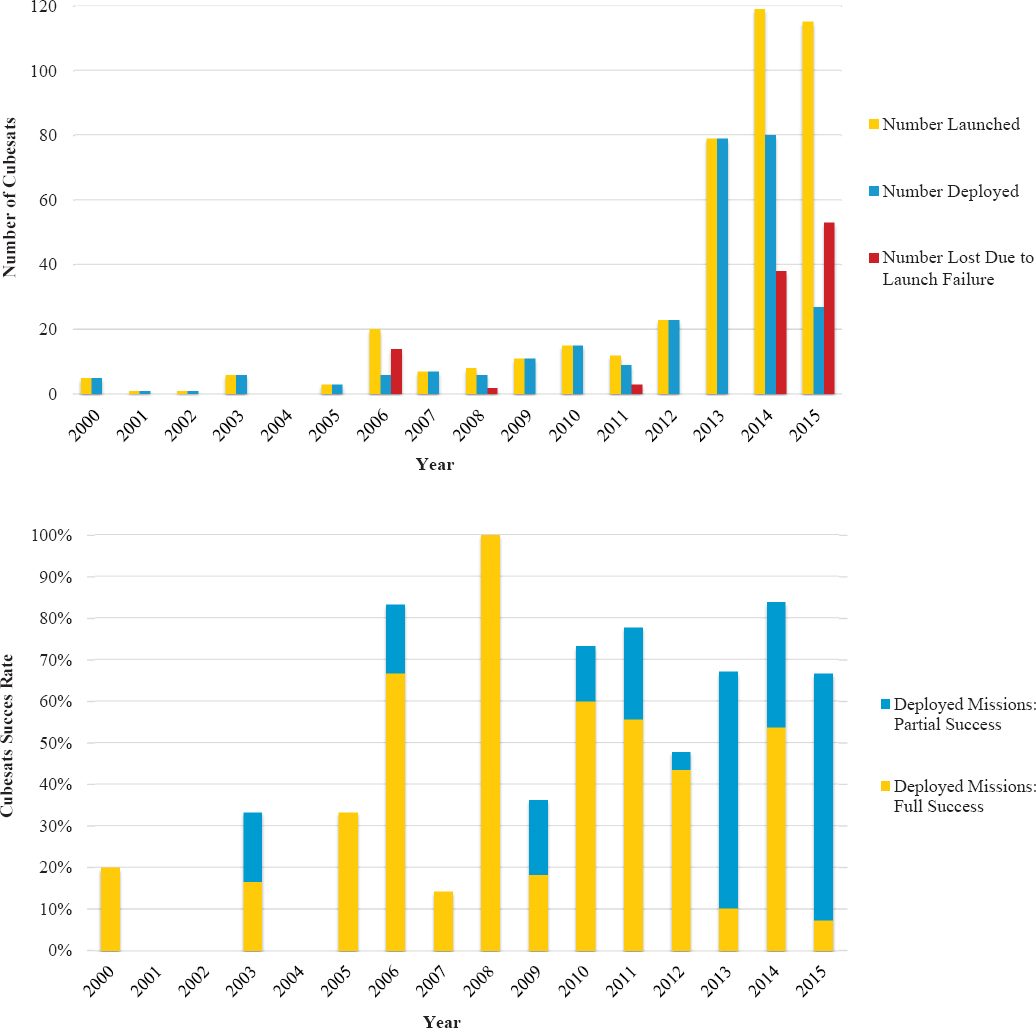
orbit after launch with a full success rate.16 The success rate, which meets partial and full success criteria, for the NSF CubeSats (including reflights) is at 11 of 12 (92 percent). For NASA science CubeSats, the success rate (partial and full success criteria) is 83 percent through 2015. In the committee’s judgment, the strong motivation for a successful mission—for the sake of science as well as adequate funding to address any preflight issues or risks—are likely contributing to these high success rates for the NSF and NASA CubeSat-based science missions.
___________________
16 Note that 12 of the 13 NSF CubeSats that have launched also deployed into space, but CADRE (launched in December 2015) is awaiting deployment from the ISS in 2016.


















